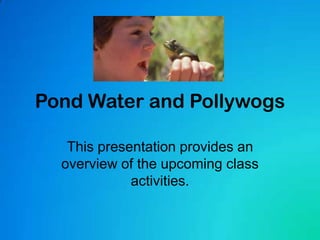
Frog Life Cycle Project
- 1. Pond Water and Pollywogs This presentation provides an overview of the upcoming class activities.
- 2. Questions That We Will Answer Essential Question: 1. How have different species of animals adapted to their environment? 2. Why do people say “ There is no place like home”?Unit Questions: 1. What can we do to help people become aware of the importance of frogs?2. How does a frogs classroom compare to its home in the wild?Content Questions:1. What is the life cycle of a frog?2. What is needed for a healthy frog environment?3. What are special adaptations that help frogs to live in specific environments?
- 4. The activities will be guided by the following student objectives:Understand a frog's life cycle and development by hatching frog eggs and observing tadpole growth and development Describe the characteristics of frogs and compare them to characteristics of toads Describe the characteristics of amphibians as contrasted to fish, reptiles, or mammals Describe a frog's habitat and how it supports the life of a frog Work cooperatively in small groups Document observations in a journal or learning log Ask questions, gather research, organize information, prepare data, and present findings in writing
- 5. Role of The Teacher While teaching this unit, I plan to make sure I use all different techniques so I can reach every one of my students. I will be creating many hands on activities, as well as group work. I will oversee to make sure they are completely all activities properly. I look forward to working with every child in this unit.
- 6. Roles of Students and Parents Students will be responsible for keeping a journal that includes research, data, and drawings of their findings from observing their frogs. Students will be divided into groups and will work together to create a newsletter illustrating the frog life cycle and habitat, both natural and man-made, and give specific details about the exhibit. Students will also take a trip to a local pond to observe a natural frog habitat. At the end of the unit the students will have a class slideshow presentation they have created, a newsletter, and a real frog exhibit. We want to take the newsletters to a local zoo as well. As for parents, we could always use help on our small field trips and help in the classroom with activities. I always look forward to parents volunteering in my class, especially for help with reading, writing, and computer use.
- 7. Project - Based Learning? Project – Based Learning is a type of learning that demonstrates a students' performance. It involves real tasks that are challenges for kids to solve. It's very hands on, and the students create something after what they have learned. Project Based learning is something I want my students to get use to. Having them do hands on activities will help them experience the unit much more. They will be interacting with one another, using technology, and creating a habitat using what they have learned along with some of their imagination. I think Incorporating PBL is very essential.
- 8. Standards This Unit Meets ALEX Standards: 1st Grade Science (2005): 1.) Select appropriate tools and technological resources needed to gather, analyze, and interpret data. Examples: platform balances, hand lenses, computers, maps, graphs, journals 2.) Identify basic properties of objects. Examples: size, shape, color, texture 4.) Describe survival traits of living things, including color, shape, size, texture, and covering. Classifying plants and animals according to physical traits Identifying developmental stages of plants and animals Describing a variety of habitats and natural homes of animals 1st Grade Mathematics (2010): 18.) Organize, represent, and interpret data with up to three categories; ask and answer questions about the total number of data points, how many in each category, and how many more or less are in one category than in another. 1st Grade Technology Education (2009): 10.) Design original works using digital tools. Examples: tools-digital drawing tools, music software, word processing software, digital cameras
- 9. Contact Information If you ever need to get a hold of me, please email or call me at anytime. Email: mamogg69@gmail.com , mamogg@crimson.ua.edu Phone: 334-494-8668 ( I have texting as well if you must contact me immediately)